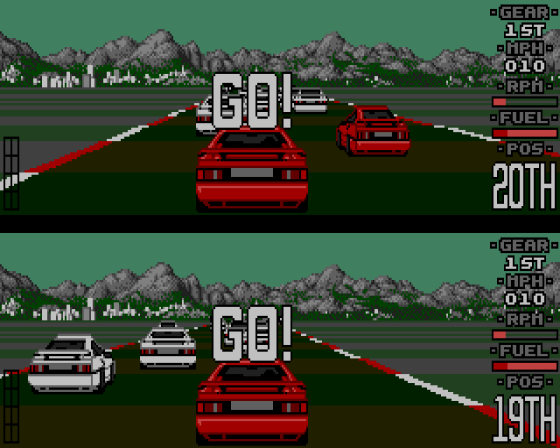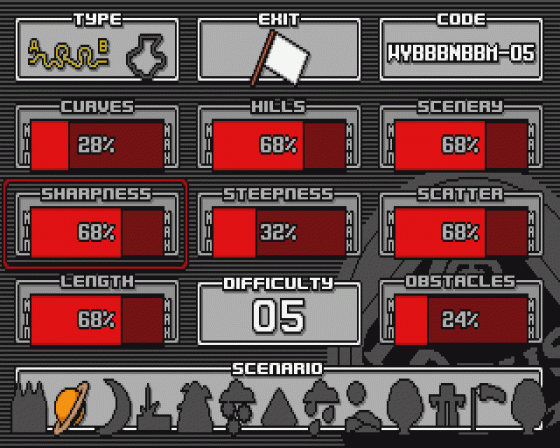
ST Format
 1st June 1994
1st June 1994
Categories: Review: Software
Author: Ed Ricketts
Publisher: Gremlin
Machine: Atari ST
Published in ST Format #58
Lotus Trilogy
Few games have been as influential in world history as the trio they're calling the Lotus Trilogy. Find out why here today...
It was the release of Lotus Esprit Turbo Challenge back in 1990 that inspired director David Lynch to create the seminal TV series Twin Peaks. Then, in 1992, came the sequel, and the trading barriers within Europe fell. And last year world war was finally eradicated forever as Lotus 3 appeared.
All right, so this isn't quite true. But they are bloody good games to play, and now you can own them all in Gremlin's super deluxe slinky black box bumber edition, Lotus Trilogy. Join with us now as we delve into the murky depths of fast cars with overhead cams...
Lotus Esprit Turbo Challenge
There are two ways to create a racing game. One way is to opt for the serious approach and involve the player with the intricacies of tyre hardness, engine mountings, gear ratios and the like. Formula One Grand Prix from MicroProse took this route and while it's ultimately a pretty enjoyable game, it's certainly not something you can pick up from a mere couple of minutes' play.
The Challenge games go to the other extreme. "Sod realism!" they practically scream in your face. "Just get in there and drive like a 22 year old rep who's just been given an MR2!" This is particularly the case with the first of the trio, which is, of course, the simplest.
There's nothing fancy here. You're presented with your Lotus Esprit Turbo SE (capable of speeds up to 150mph), plonked onto a racetrack, and from then on it's up to you. All you need to do is outwit the other nineteen challengers with careful driving and ridiculous speed, navigate the twisting courses which become hillier and more obstacle-strewn as the races go on, and you've won. Couldn't be easier.
Control by keyboard or joystick is a cinch, though you aren't given the option of using the mouse, unfortunately, which would have provided much tighter control around those bends. But who wants things that easy, anyway? Two methods of acceleration are provided: you can either hit Fire or push forward on the joystick, depending on your personal whim. Changing between the fire gears is accomplished by pulling back or pushing forward while hitting Fire. This can occasionally cause complications if, for example, you really want to accelerate but accidentally pull back at the same time, ending up going round a corner at 110mph in second. Still, Lotuses are built to last; that's why they never crash. When you hit something, the fine upstanding product that is a Lotus car simply slows down to a crawl, while the other car instantly cumples into a small heap of coloured metal. Or at least they would do if Lotus could have their way.
As usual, the two-player mode is the most fun. That's not to say the single-player mode isn't any cop, though. For once, the other drivers show some signs of intelligence, battling to regain their position after you overtake instead of just magically disappearing up someone else's exhaust pipe. You wouldn't expect much graphically of a four year old game, and you'd be right; we're talking simple scenery with some good 3D here - or at least I am - and ear-bending sound effects. Oddly the split-screen effect is used even if only one player is active, so you essentially get half a screen's worth of action. It all looks slightly cramped.
Although you're likely to play Lotus 1 the least of the three games in the pack because it has least to offer, it's still simple arcade fun and ideal for a quick blast when you're not too bothered with niceties such as decent graphics. Which leads us on to...
Lotus Turbo Challenge 2
Turbo Challenge 2 expands upon the first game rather a lot. As you might expect, the basic idea is still to drive insanely fast along crowded roads for the hell of it, but here the roads are rather more crowded and dangerous. For a start, you get away from the safety of circuit tracks and out into the wild. There are eight stages, set in a forest, at night-time, in fog, in snow, in a bloody great desert, a city, a marsh and a storm.
As before, the idea is to reach each checkpoint of each race within the given time (and if you're really big and clever, ahead of the other drivers). Now, though, you're driving either a straight Lotus Esprit or the spankier Lotus Elan, the car being chosen automatically depending on the stage. Control systems are exactly the same (keyboard or joystick, Fire or push forward to accelerate, manual or auto gearbox) so you can practise with the somewhat easier first game and use your skills for this one.
This is not a simple game. On the later levels you really have to (if you must) "motor" to meet the timechecks, and the other cars don't help a hell of a lot. Frustration at your own incompetence can easily be compounded by the annoying sound effects; your vehicle sounds more like a model aircraft than a highly expensive performance car, and you're better off without them. The weather effects are pretty, though, particularly the fog and snow, and the 3D works well. For maximum enjoyment you require four people, answered themselves, "good idea." And thus was born Lotus III.
OK, same deal here. Lots of racing around circuits in Lotus cars, not crashing but slowing down, meeting checkpoints and so on and so on. But (but! but!) Gremlin have rather cleverly added RECS: Reader Environment Construction System (you can see why they stick to the abbreviation). This ingenious idea enables you to create over three trillion different courses, and all by typing in a few letters. You see, each track, which you can define, has a number of variables which set its characteristics: number of hills, sharpness of bends, weather conditions, setting and so on. By typing a word into the RECS system a new unique course is generated from the letters in some strange and mysterious way, so you need only remember the keyword to get back to that course. You can do it the other way round too. If you want a real challenge, you set up a course with masses of hills, stupidly sharp corners, snow and anything else you desire, and the system produces the password for you. It's a marvellous idea. You can, for example, type in someone's name and see whether the corresponding course suits their personality... or maybe that's a little too philosophical. Whatever, the system works perfectly in theory, and you never run out of courses to race around.
The scenarios deserve a mention too. There are thirteen of them this time, from futuristic settings which include checkerboard turbo zones that accelerate you massively, to mountainside, snowy and motorway scenes. The latter gives you the chance to live out your fantasies by ploughing through the central reservation and trying to dodge the oncoming traffic (note the word "trying"). While the graphics and particularly the sound effects aren't much of an improvement over the second game, there's enough variety to be had from the settings to keep ennui at bay.
Lotus III is certainly the most durable of the three games because of its versatility. Like Lotus 2, it still suffers somewhat from only being really enjoyable with two players (thanks to the lack of crashes and the unimpressive AI for the other drivers), but you'd have to be a very serious rev-head indeed to write it off for that.
Verdict
You might think that buying three versions of what amounts to the same game is a waste of time and money. No no no. Each of the trilogy has its own feel and attractions: with the first, it's the fact you can get into the race with the minimum of fuss; the second has the excellent four-player option and improved graphics, while the third can be tweaked to your satisfaction almost infinitely.
If you can't get your head round the complexities of Formula One Grand Prix, and the hours of practice needed for Vroom and F1 seem like too much effort, there's bound to be something here to tickle your motoring fancy. And if it turns out there isn't, you can keep the collection in mint condition and sell it as a collector's item years in the future. Probably.
Go on, buy it. We dare you.
Highs
- Three landmark games for the price of one and a bit can't be bad.
- Lotus III should keep you at it forever.
Lows
Not very complex - stay away if gear ratios excite you.
Other Atari ST Game Reviews By Ed Ricketts
Scores
Atari ST Version| Overall | 91% |













